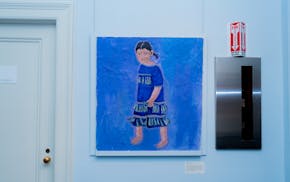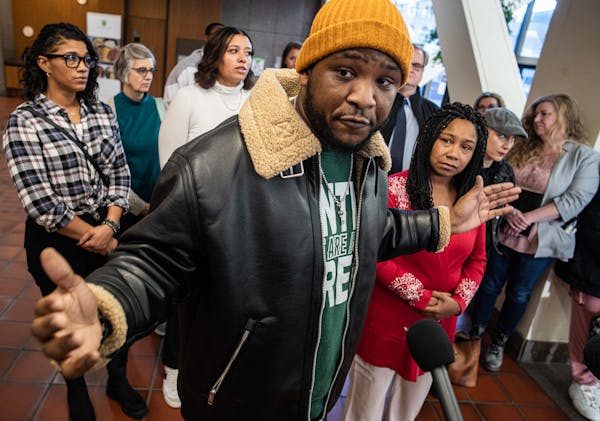I'll never forget the sound of his screams.
In 2005, I was an intern at the Star Tribune when I was asked to cover the verdict in the trial of Marvin Haynes, a 16-year-old who had been accused of the 2004 murder of Randy Sherer, a 55-year-old employee at Jerry's Flower Shop in Minneapolis.
I'd just turned 22 when I walked into the courtroom to write the story.
I had never covered a murder trial, so I didn't know what to expect.
When the jury returned and the judge prepared to read the verdict, I locked eyes with a juror who shed tears as she sat down. I knew what was coming then. As the judge announced that Haynes, who has always denied he'd committed the crime, had been found guilty of murder, I looked at the teenager.
"I didn't kill that man! They're all going to burn in hell for that!" Haynes screamed as he stared at the jury.
He was close enough to touch.
His reaction became the headline. But I often thought about the tears that followed his screams.
Per the National Registry of Exonerations, 3,431 people in the United States have had wrongful convictions overturned since 1989. "More than 30,250 years lost," its website says.
Haynes, who has spent almost 20 years in prison after he was sentenced to life, is seeking to have his case overturned with the help of the Great North Innocence Project, which submitted it to the Minnesota Attorney General's Office Conviction Review Unit in 2022.
The federal and state investigations of the Minneapolis Police Department have led to ongoing scrutiny of its practices, culture and policies. It's clear that a systemic upheaval is the only path to change. But the conversation around the department's documented history of discrimination, bias and violence against communities of Blacks, Indigenous or people of color in the Twin Cities should also include past verdicts and its work with the Hennepin County attorney's office. Why should anyone believe the questionable convictions that disproportionately involve Black and brown folks — reviewed by the Great North Innocence Project and other parties — that originated with a department that had engaged in those clear inequities?
I understand the Sherer family's demand for accountability. But Cynthia McDermid, Sherer's sister, identified the wrong man — he had an alibi — in the initial lineup presented to her. McDermid, who was in the flower shop when the assailant entered the store, described him as nearly 6 feet tall, 180 pounds. Haynes is 5-foot-7 and weighed 130 pounds. In a second lineup, Minneapolis police showed her an old photo of Haynes, when his haircut fit the profile of the man she initially described as the killer.
Also, one of the key witnesses was Haynes' 14-year-old cousin, Isiah Harper, who has since recanted his original testimony that Haynes called him to confess. He did not have a parent present during his interview. Minneapolis police also showed McDermid, who died in 2020, a series of lineups that featured Haynes, a maneuver then-Minneapolis police Sgt. Michael Keefe called "reckless."
And Haynes' four sisters said he was home asleep when the shooting happened. "We know he didn't do it," Sherita Coleman, one of the sisters, said at the time. "I was supposed to be a witness. He was at home."
Investigators said Haynes changed his story multiple times. But it's unsettling that Haynes' family said they weren't offered an equal opportunity to provide an alibi for his whereabouts that day. Plus, a critical witness — his cousin — said he tied Haynes to the crime because he was threatened with prison time if he refused.
As a young reporter with my first journalism job, I stood in the courtroom in 2005 and assumed the right guy had probably been identified. You have to understand the narratives that police control here. When you're a young reporter and you show up to the scene of an alleged crime or an ongoing investigation, the police have the power to shape the truth. And I lacked the instincts I have now to always investigate the investigation.
I should have followed up on that verdict with more stories, more questions.
Instead, I wrote a piece that I'm not proud of.
Today, I question the language in the story I wrote about Haynes' conviction in 2005 with former Star Tribune staff writer Margaret Zack. We called Haynes' reaction to the verdict "an unusual courtroom outburst." How would I know that? I was an intern at my first murder trial. And what's "unusual" about a man, who claims he's innocent, fighting for his freedom?
I don't know if Haynes was in the flower shop that day in 2004, but the missteps in his case have kept him on my mind for nearly two decades.
When I walked into that courtroom, I felt like I'd just started my life.
Sherer tragically and unjustly lost his. But Haynes has raised credible arguments that, on that day, he did, too.

Medcalf: This summer, let's all be more vigilant about our children — and everyone else's

Medcalf: Mia program provides safe space for young people to create

Medcalf: George Floyd's daughter, now 11, on life without her dad: 'It's hard'


